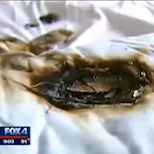A news report about a small fire with no injuries took the internet by storm last week. The question is why.
The story is about a Dallas area teen who says her cellphone caught fire beneath her pillow as she slept
The teen went to sleep with her Samsung Galaxy S4 under her pillow and awoke to a smouldering mess, according to KDFW, a Dallas-Fort Worth Fox affiliate. The father of the teen told KDFW he thinks the phone battery may have caused the meltdown, Samsung says the battery was not an original part but was a replacement unit.
The video has generated more than 1.1 million YouTube Views, 4 million page views on the station’s website and generated even more for the other Fox owned and operated stations that posted the story. Until now, the station’s YouTube record stood at 27,000. KDFW Consumer reporter Steve Noviello says he has never seen anything like it, but says there are some solid reasons for its success.
“The story is easy to relate to and pulls on those ‘holy grail’ elements that news consumers love- ‘Your Children, Your Safety, Your Stuff,'” he said.
And he says he wrote the online story in a way that he thought would appeal to that audience differently than the TV story. “The way I posted the story was very deliberate- in addition to shooting video, I snapped some cellphone pics. When it came time to post I did so with the cell photos not the standard generic news logo or freeze frame from the package.” Noviello says the Fox stations that used the snapshot photo as their lead image saw about double the return as those that used a freeze-frame from the story.
Stations often don’t post news stories on YouTube preferring instead to drive viewers to station website pages. But YouTube does offer compensation from a share of advertising revenue it generates in pre-roll ads on popular videos.
Noviello said the large YouTube viewership helped the online site. “We didn’t get wrapped up in where the traffic was going, only that it was flowing. This ‘viral’ was a first for us and the data is very useful. As opposed to trying to ‘direct’ all traffic back to our website to make the folks upstairs in sales happy, we got it out there and watched the rising tide lift all boats.” In short, he said, we stopped trying to force the viewer to come to where “we are” but tried to reach them where they are.
Noviello said 65 percent of the 1 million plus YouTube views were from mobile phones.
I had to ask why Noviello believed the story to be real. “We did another story some time back about lithium ion batteries and I have had hundreds of e-mails from people who tell me their batteries get hot. It has included everything from phones to e-cigarettes and baby monitors,” so the story of the phone fire beneath a pillow was not a big surprise.
That safety issue is not just a scare tactic. A Pew Research report says most teens sleep with their cell phones. And it is not just a “teen thing.” Pew says 65% of adults say they sleep with their phones in the bed or next to the bed too. “Samsung does warn you not to put your phone in your bed, but the warning is on page 208 of the phone’s user manual,” Noviello said. When he wrote the story summary Noviello mentioned the buried warning saying, “13-year-old sleeps while her cell phone smolders under her pillow. The manufacturer points to a warning you’ve likely never read.”
Noviello is producing additional stories about battery safety. “The stories we are hearing about are not all replacement batteries.” The Consumer Product Safety Commission set standards in 2007 but today’s electronics are different from older devices. The question arises about whether the old standards should apply to today’s equipment.
For newsrooms, especially TV newsrooms, this story goes against conventional wisdom about what kind of video will generate the most online traffic. The conventional wisdom and experience is that raw or nearly raw sensational video of spot news or oddities are the viral traffic winners. But this story is a completely packaged news story that ran online just as it aired on TV. The lesson seems to be that new and compelling content attracts viewers.









Comments